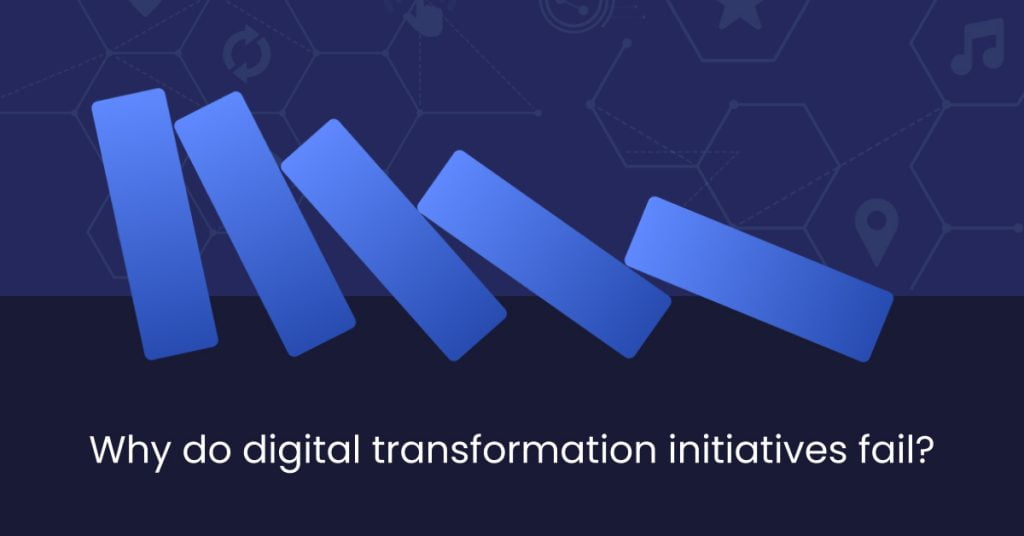
Digital transformation has become a buzzword in today’s fast-paced business landscape. Companies in all industries want to use AI (Artificial Intelligence) and ML (Machine Learning) to stay competitive. Yet, a lot of these efforts to transform don’t produce the expected outcomes. So, let’s understand the reasons behind digital transformation failure.
The 84% Conundrum
As organizations embark on their Digital transformation journeys, it’s essential to acknowledge the statistics. In 2016, Forbes said the risk of digital transformation failure was 84%. Big consulting firms like McKinsey, BCG, KPMG, and Bain & Company say the risk is 70% to 95%. These statistics serve as a stark reminder that something is amiss in the Digital transformation landscape.
So, why do these well-intentioned efforts fall short, and what can we learn from them?
In this blog, we’ll dive into the 12 critical reasons leading to digital transformation failure, drawing insights from the experiences of countless organizations over the years. Our aim is to shed light on the pitfalls to avoid.
12 Reasons Leading to Digital Transformation Failure
1. Strategic Misalignment
When organizations embark on digital transformation journeys, it’s essential to have a clear strategic alignment with their core business objectives. This means setting specific financial goals and performing net present value (NPV) calculations to understand the potential returns on investment. Without this alignment, Digital transformation efforts can become disconnected from the organization’s overarching mission, leading to wasted resources and a lack of measurable progress.
2. Organizational Blind Spots
Human resistance to change is a natural response, particularly when employees are not adequately informed or educated about the reasons behind new technologies, tools, or processes. To overcome this hurdle, organizations need comprehensive communication plans and training strategies that ensure all stakeholders understand the purpose and benefits of the Digital transformation initiative. Open, transparent communication can help mitigate resistance and digital transformation failure.
3. Leadership Balance
While technical ability is invaluable in Digital transformation projects, leadership skills are equally important. Placing individuals with strong technical backgrounds in leadership roles can sometimes lead to micromanagement or a lack of focus on crucial soft skills. Digital transformation initiatives thrive when leaders can effectively manage teams, communicate across departments, and inspire collaboration while understanding the technical aspects.
4. Navigating the Details
Attention to detail is a valuable trait, but it should not overshadow the broader strategic vision. Organizations must nurture the strengths of detail-oriented team members while providing them with training and guidance to transition from micro-level thinking to macro-level strategic planning. This balance ensures that important minutiae do not obscure the overarching goals of the Digital transformation project.
5. Temptation of Technology
In the digital age, it’s easy to be seduced by the latest technology trends. However, implementing technology without a well-defined and practical use case can be costly and counterproductive. Organizations must perform thorough cost-benefit analyses and develop a solid business case for any technological adoption to ensure that it aligns with their strategic objectives and provides tangible value.
6. Bridging the Communication Gap
Digital transformation initiatives often involve complex technical discussions that can alienate non-technical stakeholders, including executives and decision-makers. To prevent isolation, misalignment and Digital transformation failure, leaders must become effective translators, conveying the importance of their efforts in terms of user experience (UX) and financial benefits rather than relying solely on technical jargon.
7. Vendor Management Challenges
Many Digital transformation initiatives involve external vendors, and without clearly defined expectations, timelines, and consequences for unmet commitments, these relationships can become problematic. Establishing strong vendor management practices is essential for maintaining control over project timelines, budgets, and deliverables, ultimately ensuring the successful execution of the Digital transformation initiative.
8. User Empowerment
Assuming that users will effortlessly adapt to new interfaces or technologies can lead to frustration and resistance. To ensure a smooth transition and minimize disruptions, organizations must invest in comprehensive user training and ongoing support. Empowering users with the necessary skills and knowledge enhance their confidence and receptiveness to change.
9. Talent Retention Battle
In today’s competitive job market, organizations risk losing talented individuals to competitors offering better compensation packages and more flexible work arrangements. To retain valuable employees, organizations should focus on creating a positive work environment, offering competitive compensation, and providing opportunities for professional growth and development.
10. Overcoming Resistance
Internal resistance often stems from employees’ fears of job security when facing automation or digitalization. To address this, organizations must communicate transparently and consistently. Emphasizing that Digital transformation initiatives aim to enhance employees’ roles, improve efficiency, and create new opportunities can help alleviate concerns and encourage collaboration.
11. Urgency for Decision-Making
Digital transformation initiatives require prompt decision-making to capitalize on opportunities and keep a competitive edge. Unfortunately, the absence of urgency, often linked to a lack of understanding of delay costs, can result in slow decision-making processes subsequently leading to digital transformation failure. Leaders must educate decision-makers about the potential consequences of delays and emphasize the importance of prompt action.
12. Strategic Development Focus
Prioritizing Digital transformation project development based on political considerations rather than profitability and strategic alignment can lead to confusion and inefficiency. To maintain focus and direction, organizations should set up clear criteria for project prioritization, ensuring that projects align with the overall strategic vision and provide measurable benefits. This data-driven approach lowers the chances of Digital transformation failure.
The Role of Leadership: Bridging the Gap
Good leadership is key to connecting advanced technology and people. To succeed in digital transformation, leaders need technical ability and strong interpersonal skills. They can simplify technical terms so non-experts understand them. This helps everyone in the organization understand and agree on the same goals.
These leaders play a crucial role in mitigating resistance to change. Their goal is to make sure that all employees understand the advantages of Digital transformation. They also work to encourage cooperation between different teams. They manage agile teams, promote innovation, and focus on achieving digital transformation goals.
Conclusion
In essence, digital transformation failure is predominantly due to human factors rather than technological shortcomings. As the blog points out, digital transformation is 80% about soft skills and 20% technology.
As one of the leading digital transformation companies in UAE, SquareOne Technologies acknowledges these challenges and offer a holistic approach to digital transformation. Our expertise lies not only in technology but also in understanding the intricate human dynamics at play during digital transformation initiatives. By addressing these human-centric challenges, we help organizations navigate the digital landscape with confidence and improve their chances of success.
Partner with SquareOne and embark on a digital transformation journey. Leverage latest technology and harness the power of human potential for a transformative future.


















